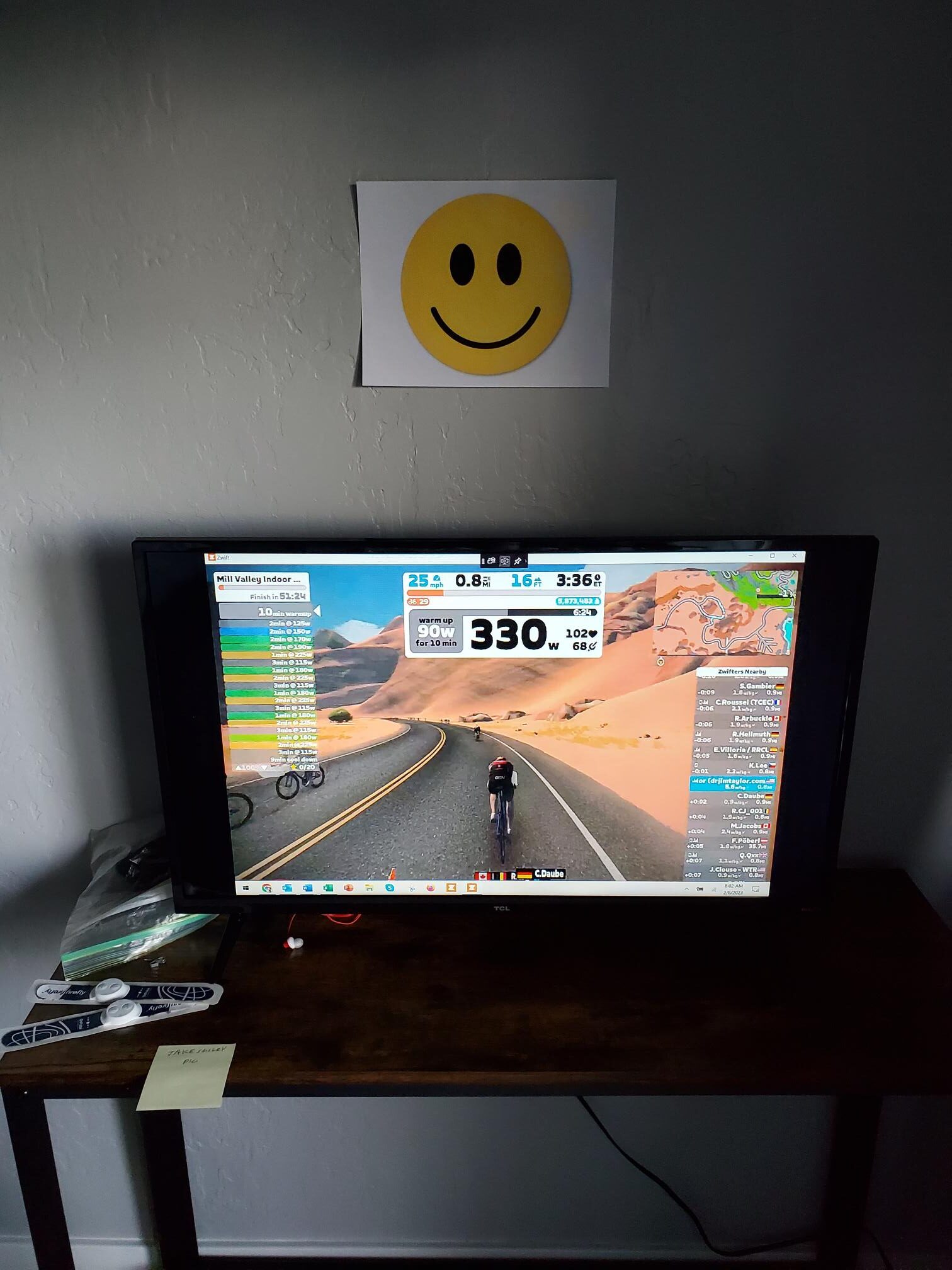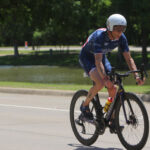One of the strangest and most effective tools I’ve come across to manage intense effort and exertion pain is something that we do often without realizing how powerful it truly is. Let me explain. A few years ago, I was working with a pro triathlete who was having a terrible track workout. She wasn’t hitting her splits and her coach was none too happy with her efforts. She approached me during a break feeling frustrated and angry, and her body was in knots. She asked me what she could do. I didn’t have a good answer until an idea just popped into my head. I told her to smile. She said, I don’t want to smile. I told her to smile. She said she was not happy and didn’t want to smile. I told her again to smile. This time, just to get me off her back, she smiled. I told her to hold the smile. During the next two minutes there was an amazing physiological and psychological transformation. As she stood there with the smile on her face, the tension drained out of her body. Her frustration and anger subsided. Her breathing became slow and deep. She said that she was feeling better. In a short time, she was looking more relaxed and happier. She returned to training, her efforts improved, and she made some progress during the remainder of the workout.
an idea just popped into my head. I told her to smile. She said, I don’t want to smile. I told her to smile. She said she was not happy and didn’t want to smile. I told her again to smile. This time, just to get me off her back, she smiled. I told her to hold the smile. During the next two minutes there was an amazing physiological and psychological transformation. As she stood there with the smile on her face, the tension drained out of her body. Her frustration and anger subsided. Her breathing became slow and deep. She said that she was feeling better. In a short time, she was looking more relaxed and happier. She returned to training, her efforts improved, and she made some progress during the remainder of the workout.
Do you know what my first thought was? Wow am I good! But seriously, her response was so dramatic that I wanted to learn how such a change could occur. When I returned to my office, I looked at the science related to smiling and, to my surprise, there is quite a robust body of research examining the effects of smiling on our psychology, emotions, physiology, and, importantly to us, athletic performance.
I should add that, when I talk about smiling, I don’t mean that you smile because you are happy, enjoying yourself, or you find something amusing (i.e., called a Duchenne smile). That is decidedly difficult to do  when you are in your ‘hurt locker’ during an intense workout or a race. Rather, smiling is a motor skill that involves raising the sides of your mouth. And the research indicates that the simple act of smiling, even if forced, can elevate your mood, just like similar research examining frowning has found that turning your mouth downward can lower your mood.
when you are in your ‘hurt locker’ during an intense workout or a race. Rather, smiling is a motor skill that involves raising the sides of your mouth. And the research indicates that the simple act of smiling, even if forced, can elevate your mood, just like similar research examining frowning has found that turning your mouth downward can lower your mood.
General Impact of Smiling
Smiling has such a big impact on us for two reasons. First, as we grow up, we become conditioned to the positive effects of smiling. In other words, we learn that when we smile, it means we’re happy and life is good, so when we smile, we generate pleasant associations, such as positive self-talk and memories, that make us feeling better. Second, there’s been some fascinating research looking at the effects of smiling on our brain chemistry. This research has found that when we smile, it releases brain chemicals, such as dopamine, which makes us feel happier, and serotonin, which reduces stress. It also lowers our blood pressure, strengthens our immune system, and eases our pain.
our brain chemistry. This research has found that when we smile, it releases brain chemicals, such as dopamine, which makes us feel happier, and serotonin, which reduces stress. It also lowers our blood pressure, strengthens our immune system, and eases our pain.
This influence is consistent with the idea of “embodied emotion,” which posits that our facial expressions (and our posture, for that matter) has a reciprocal relationship with our emotions, meaning our physiology can affect our emotions and our emotions can affect our physiology. Simply put, it’s difficult to think and feel in ways that are inconsistent with the messages your body is sending you.
Impact of Smiling on Athletic Performance
Those are just the general benefits of smiling. Smiling also has been found to improve athletic performance in several ways. First, research has reported that smiling and frowning influence both our affective states (i.e., our mood) and our perceived effort. Specifically, when cyclists rated their mood and  perceived effort while riding an indoor bike at 50-60% of maximal heart rate, their mood was higher, and their perceived effort was lower when smiling as compared to when they were frowning. Additionally, smiling produced lower oxygen consumption and lower energy expenditure among runners compared to when they frowned. Conversely, frowning, a not-uncommon reaction to exertion, appeared to increase perceived effort, suggesting that frowning may actually hurt your efforts.
perceived effort while riding an indoor bike at 50-60% of maximal heart rate, their mood was higher, and their perceived effort was lower when smiling as compared to when they were frowning. Additionally, smiling produced lower oxygen consumption and lower energy expenditure among runners compared to when they frowned. Conversely, frowning, a not-uncommon reaction to exertion, appeared to increase perceived effort, suggesting that frowning may actually hurt your efforts.
Smiling may improve running economy by having a relaxing effect on our bodies, which increases efficiency, while frowning may hurt endurance-sport performance by elevating body tension, thereby decreasing efficiency. Smiling, and its commensurate emotional and physiological changes, may also distract us from the fatigue and pain we may be feeling, so we don’t notice our effort has much.
You really want to know how powerful a mental tool smiling can be? This piece of research is quite mind blowing. During a time-to-exhaustion effort, two groups of cyclists were presented with subliminal (i.e., outside of conscious awareness) happy and sad faces, respectively. The cyclists who were “primed” with happy faces rode 12% longer than those primed with sad faces. The “happy” cyclists also indicated a lower perceived effort. By the way, a similar and more powerful effect was found when cyclists used positive self-talk.
happy faces rode 12% longer than those primed with sad faces. The “happy” cyclists also indicated a lower perceived effort. By the way, a similar and more powerful effect was found when cyclists used positive self-talk.
Tips to Get the Most Out of Smiling
So smiling shouldn’t just be something you do when you’re feeling good. Instead, you should use it as a mental tool to make you feel better and to improve your training and race performance. Here are some tips for how you can get the most out of your smiling:
- Try to conjure “real” smiles: Genuine smiles may be more effective at positively influencing your physiology and psychology than “fake” smiles (yes, your brain can tell the difference!). As hard as it is during extreme exertion, do your best to focus on things that will allow you to produce a real smile
 (e.g., a happy song, a fond memory, how it will feel when you achieve your training or race goal). If you can’t quite make that happen, then just raise the sides of your mouth into a fake smile (as it can also work, perhaps just not as well).
(e.g., a happy song, a fond memory, how it will feel when you achieve your training or race goal). If you can’t quite make that happen, then just raise the sides of your mouth into a fake smile (as it can also work, perhaps just not as well). - Identify situations in your training and races that would benefit most from smiling (e.g., toward the end of intervals during a HIIT workout, a long climb on the bike or run, the last few miles of race).
- Make smiling a consistent part of your training: Train yourself to smile at different points in a workout or race. For example, you could practice smiling during the last 20% of an interval or set an alert on your watch to vibrate or ping every 10 minutes. At first, it will take some focus and effort.
 But, in time, you will ingrain smiling into a habit that happens automatically when you need it most.
But, in time, you will ingrain smiling into a habit that happens automatically when you need it most.- For your indoor workouts in your “training cave” (I don’t like to call mine a “pain cave” because of the negative connotations), whether indoor bike, treadmill, or strength, you could write “SMILE” on a piece of paper or, better yet, print out a smiley face (the latter is my strategy of choice) and tape it to the wall in your field of vision (e.g., above your laptop or TV) as a constant reminder to smile.







